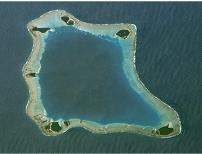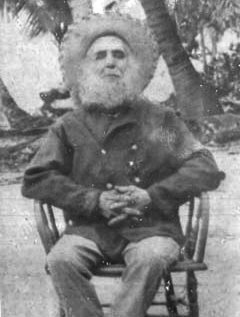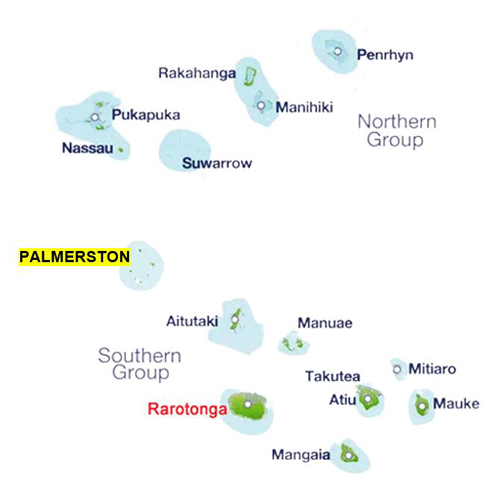PALMERSTON
An Englishman's legacy
Owned by the descendants of its English founding father
The only island Captain Cook set foot on himself
Palmerston is part of the Cook Islands, but owned legally by the descendants of 19th century Englishman, William Marsters. It's an atoll made up from the summit of an old volcano which rises 4,000 metres (13,123 feet) from the ocean floor. At its highest point, it's just 4 metres (13 feet) above sea level. Six main islets and multiple rocks and sandbanks are scattered around the lagoon which stretches for 39 sq. kms. Islanders live on the eastern most islet which they call Home Island. The land near the reef is infertile, but there are typical atoll tree crops of coconut and pandamus. The island is a major nesting site for the green turtle and rare seabirds. Life on Palmerston has a rhythm of its own and includes daily church services. Everywhere is immaculately tidy
LOCATION: 500 kms/310 mls North West of Rarotonga
ACCESS: Very difficult
TOURIST ACCOMMODATION: None
POPULATION: 25
LAND AREA: 2.1 sq. kms/0.8 sq. mls
GETTING THERE/STAYING
With no airstrip and no regular boat service, it's not easy. Ask at the Harbour Master's office on Rarotonga about any planned sailings or to see if any private yachts are heading that way. It's typically a two or three day journey by sea in often difficult conditions. There's no tourist accommodation so if you want to stay you'll have to arrange it with a local family. Visitors on yachts also need to note there are strict biosecurity measures in place and all vessels will be searched
Around the reef are six groups of islets (motus). These are North Island, Lee To Us, Leicester, Primrose, Tom's and Cooks. Leicester may have been named after the English county of Leicestershire where founding father, William Marsters grew up
GETTING THERE/STAYING
With no airstrip and no regular boat service, it's not easy. Ask at the Harbour Master's office on Rarotonga about any planned sailings or to see if any private yachts are heading that way. It's typically a two or three day journey by sea in often difficult conditions. There's no tourist accommodation so if you want to stay you'll have to arrange it with a local family. Visitors on yachts also need to note there are strict biosecurity measures in place and all vessels will be searched
LOCATION: 500 kms/310 mls North West of Rarotonga
ACCESS: Very difficult
TOURIST ACCOMMODATION:None
POPULATION: 25
LAND AREA: 2.1 sq. kms/0.8 sq. mls
Around the reef are six groups of islets (motus). These are North Island, Lee To Us, Leicester, Primrose, Tom's and Cooks. Leicester may have been named after the English county of Leicestershire where founding father, William Marsters grew up
FACT FILE
- Captain Cook discovered it on his second voyage in June, 1774 and went ashore on Sunday, 13 April, 1777, during his third Pacific voyage. Both times he found the island uninhabited
- Named by Cook after First Lord of the British Admiralty, Lord Palmerston who was the father of a future British Prime Minister
- The ancient name was supposedly Ava Rau, meaning 200 channels or harbours
- The 'Bounty' mutineers touched on Palmerston but decided it wasn't what they were looking for, according to 19th century British missionary, the Rev. William Wyatt Gill

Palmerston from the space shuttle
Photo: NASA

"The Telecom"
A vital link to the outside world
OFF THE MAP
The island is so remote, it wasn't even properly located on maps until 1969! Up and till then, its position was based on Captain Cook's original charts which showed it 10 miles (16 kms) away from where navigation satellites have now confirmed it really is

Palmerston as seen from the space shuttle Photo: NASA
"The Telecom"
A vital link to the outside world
Palmerston as seen from the space shuttle
Photo: NASA
Cargo ships call in with supplies only a few times a year, so visiting yachts help supplement the island's needs. The big dish may look out of place but it provides the only permanent link with the outside world. The internet has also reached this remote atoll although the connection can be "tempramental"
THE MARSTERS LEGACY

All the islanders are descended from one Englishman, William Marsters - described by some as a labourer and others as a carpenter and barrel maker - who arrived from Manuae on 8th July, 1863 (according to official records). Contemporary reports say he was accompanied by three Polynesian women, at least one of whom he had married.
He subsequently ended up with four "wives", although it's not clear whether he married more than one. And that was after deserting his first wife and two children in England. Marsters had 17 children by his Polynesian wives and 54 grandchildren before he died on 22nd May, 1899, aged 78
By the time William's youngest daughter, Mrs Titana Tangi died in 1973, there were over one thousand Marsters living in Rarotonga or New Zealand. Few remain on Palmerston...but wherever they live, they all consider it their homeland
THE MARSTERS STORY IN DETAIL
Another Marsters legacy is the unique way in which some Palmerston islanders speak - the legacy of an old English accent which it's said resembles that of Gloucestershire
more about the linguistic legacy
THE HOUSE THAT WILLIAM BUILT
"The Tin House"
William Marsters built his own home on Palmerston from shipwreck timbers and driftwood found on the shore soon after his landing. Most of the structure is understood to have come from the cargo of the barque 'Julia Cobb' which was en-route from San Francisco to Adelaide, Australia laden with timber earmarked for railroad building. It was wrecked off Palmerston in November or December, 1864*. The building is still in tact after more than 150 years. Only the corrugated roof is recent and the the original is still underneath.
Islanders call it "The Tin House". It stands on what's just called "the road" which runs east to west from the lagoon. The fourth photo shows how big and sturdy the timbers are, albeit some of the structure is now under attack from wood boring insects. It was also one of only two buildings to survive a disastrous hurricane in 1926 (the other was the original church also built by Marsters, but even that was lifted up and moved by the wind and waves before being rolled back into place by islanders). Today, the house is inundated with sand blown from the beach and by cyclones and is kept locked * contemporary reports differ on which month
THE CHURCH
William Marsters was converted to Christianity by the 19th century English missionary, the Rev. John Williams, who persuaded him to build the first church. This is its successor
RELIGION
Islanders dress up in their finest clothes for services held daily and several times on Sundays in the more modern church which replaced the original built by Marsters
SEA LIFE
Much of daily life revolves around the sea. Fishing is particularly good near "Kick Me Arse Rock". William Marsters gave it that name after he had a particularly fierce fight one day against the wind and tide
NATURE'S BOUNTY
Parrot fish are the island's main cash crop. They're dried or frozen and shipped to Rarotonga. The local diet is supplemented by baby Bosun birds, coconuts and breadfruit
A natural rhythm
Daily life on Palmerston has a rhythm of its own. Although (or because) the population is so small, everything is carefully organised, nothing is ever thrown away if it's likely to come in useful one day and everywhere is immaculately tidy. Former New Zealand Herald journalist , Sandra Paterson, who now lives on Rarotonga spent five weeks helping at the local school and wrote a fascinating insight into island life.
Click here to read it. She also encouraged one of the island's children to write about gospel day on Palmerston which is both a holy day and a holiday. Click here to read that
Inside a Palmerston home...and the scenery islanders wake up to every morning
DAILY LIFE ON PALMERSTON
GARDENING FOR THE CLIMATE
Students from the island's Lucky School have an extended class every Thursday morning learning about gardening which is taken by the agriculture officer on Palmerston. The Adaptation Funded PEARL Project has provided the materials for a shade garden and cabbages, string beans, bokchoi and cucumbers are now thriving.
Photos: Climate Change Cook Islands which is responsible for overseeing such initiatives
PALMERSTON TO THE RESCUE
Bill Marsters set up a rescue programme on Palmerston for the Pacific Green Turtle. The species is officially classified as endangered and the programme gives the turtle a helping hand in life from the point of hatching until the juvenile stage when it can be released back into the wild (as in the second of these pictures). These beautiful shots were taken by Matthew Mumford of New South Wales, Australia who kindly let me share them with you. Matthew says he feels extremely fortunate to have visited Palmerston and it's something he won't forget in a hurry.




